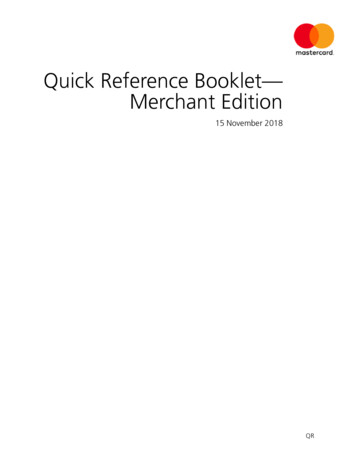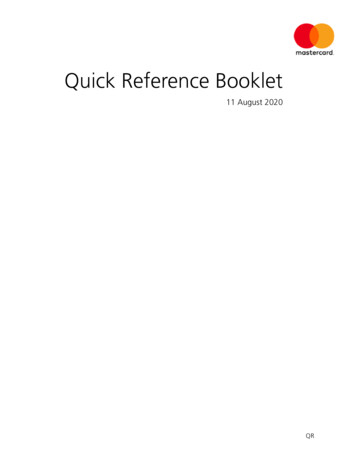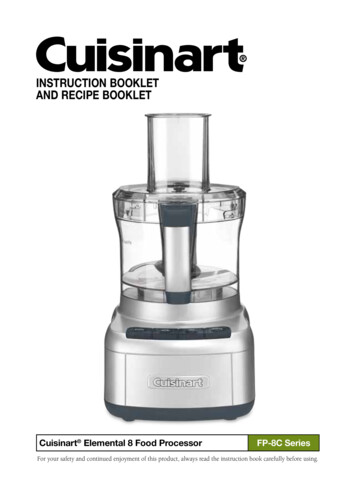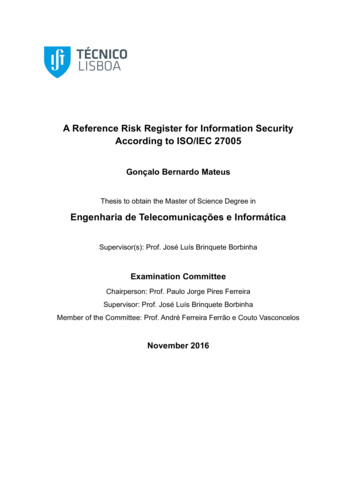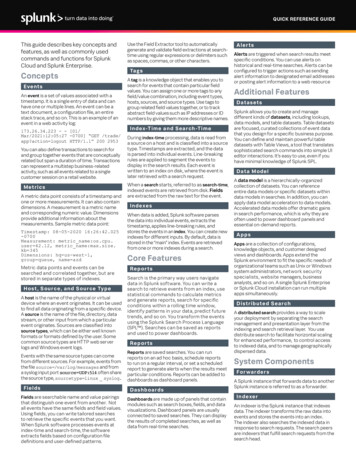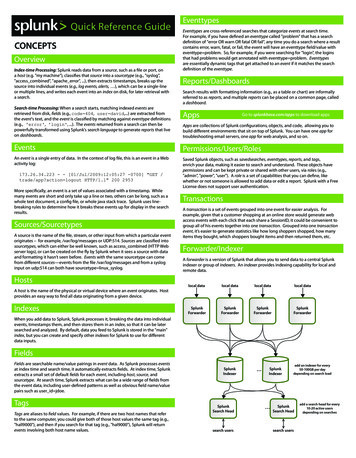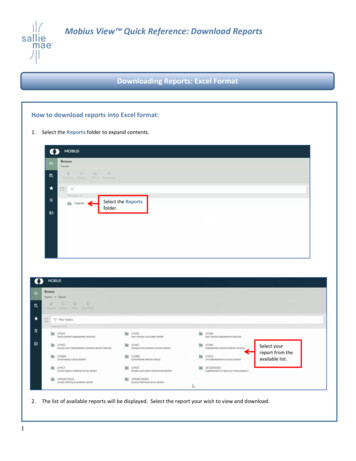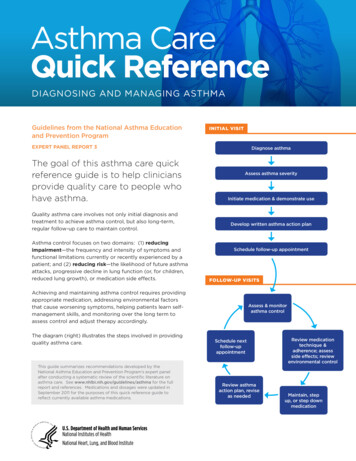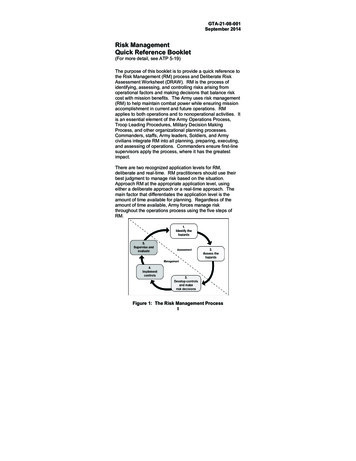
Transcription
GTA-21-08-001September 2014Risk ManagementQuick Reference Booklet(For more detail, see ATP 5-19)The purpose of this booklet is to provide a quick reference tothe Risk Management (RM) process and Deliberate RiskAssessment Worksheet (DRAW). RM is the process ofidentifying, assessing, and controlling risks arising fromoperational factors and making decisions that balance riskcost with mission benefits. The Army uses risk management(RM) to help maintain combat power while ensuring missionaccomplishment in current and future operations. RMapplies to both operations and to nonoperational activities. Itis an essential element of the Army Operations Process,Troop Leading Procedures, Military Decision MakingProcess, and other organizational planning processes.Commanders, staffs, Army leaders, Soldiers, and Armycivilians integrate RM into all planning, preparing, executing,and assessing of operations. Commanders ensure first-linesupervisors apply the process, where it has the greatestimpact.There are two recognized application levels for RM,deliberate and real-time. RM practitioners should use theirbest judgment to manage risk based on the situation.Approach RM at the appropriate application level, usingeither a deliberate approach or a real-time approach. Themain factor that differentiates the application level is theamount of time available for planning. Regardless of theamount of time available, Army forces manage riskthroughout the operations process using the five steps ofRM.Figure 1: The Risk Management Process1
RM is a five-step cyclic process broken down intoassessment and management phases. When integrating theRM process, practitioners must keep the principles of RM inmind. This will help guide their efforts. The principles of RMare: Integrate RM into all phases of missionsand operations. Make risk decisions at the appropriatelevel. Accept no unnecessary risk. Apply RM cyclically and continuously.DD Form 2977, Deliberate Risk Assessment Worksheet(DRAW), is the Army’s standard form for deliberate riskassessment. It provides a standardized means ofdocumenting the RM process. A copy of the RM Worksheetmay be found at the back of this booklet as well as athttp://www.apd.army.mil.DRAW Heading and Preparer Instruction:Block 1. Mission/Task Description: Briefly describe theoverall Mission or Task for which the deliberate riskassessment is being conducted, as well as the date(s) of themission.Block 2. Date: (DD/MM/YYYY): The date ofform preparation.Block 3. Prepared By: Information provided by theindividual conducting the deliberate risk assessment for theoperation or training. Legend: UIC Unit IdentificationCode; CIN Course Identification Number; OPORD operation order; DSN defense switched network; COMM commercialBlock 4. Sub-task/Sub-Step of Mission/Task: Brieflydescribe all subtasks or substeps that warrant riskmanagement. If necessary, refer to SOP, Field Manuals,Soldiers Manual of Common Tasks, Job Books, etc.Step 1: Identify Hazardsa. Hazards are conditions with the potential to causepersonnel injury, equipment or property damage,environmental harm, or mission degradation.b. Use the mission variables of METT-TC to identifyhazards:2
Figure 2: Mission VariablesMission - What hazards are unique to the mission? Forexample, improper material loading, and ineffective groundguide/driver communications are common hazards to railoperations.Enemy - What hazards are posed by enemy forces? Canwe expect IED, small arms, mortars, RPG?Terrain and Weather - Are road conditions favorable? Arecanal crossings stable? Are there dangers of personnelfalling from dangerous elevations? Are there waterobstacles to cross? What are the weather conditions? Willprecipitation or obscuration (i.e. blowing sand) limit visibility?Is Heat or Cold injury a hazard? Are storms forecast?Troops and Equipment - Are troops adequately trained andexperienced? Are they in good physical and mentalcondition? Are leaders competent and experienced? Iscommand climate healthy? Arecommand/control/communication systems functioning? Dowe have the right equipment for the mission? Is equipmentin safe operating condition?Time - Is there sufficient time to plan and prepare for themission? Are we rushing the mission and overlookinghazards? Is there a safer time to conduct the mission?Civilian Considerations - Will the mission createunacceptable risk to civilian personnel or property? Willcivilians pose a hazard to the mission? What are the Rulesof Engagement?NOTE: To determine the root hazard, RM practitionersconsider system inadequacies in areas such as support,standards, and training, or leadership and individual failures.3
To illustrate, tripping is not considered a hazard becauseanother condition or circumstance caused it. To identify theroot hazard, the RM practitioner must ask why a personwould trip in a certain location. Repeated questioning shouldlead to the logical answer. The root hazard is identified oncethere is no longer a logical answer to the question “why”.DRAW Instruction: Hazard: Specify hazards related to thetask or subtask in Block 5.Step 2: Assess Hazardsa. Consider each hazard identified in Step 1. When hazardsare assessed and risk levels are assigned, the resultinganalysis is a measurement of risk—probability and severityof loss linked to hazards. In the context of RM, probabilityis the likelihood an event will occur; it is assessed asfrequent, likely, occasional, seldom, or unlikely. In thecontext of RM, severity is the expected consequences ofan event in terms of injury, property damage, or othermission-impairing factors; it is assessed ascatastrophic, critical, moderate, or negligible.b. Once the probability and severity levels of a hazard havebeen determined, use the risk matrix below to determine theinitial risk level for the hazard(s). For example, if theprobability of a hazard occurring is "Likely" and the severitywould be "Critical", the initial risk level is "High”.Figure 3: Risk Assessment MatrixDRAW Instruction: Initial Risk Level. Enter the initial risklevel for each hazard in Block 6.4
Step 3: Develop Controlsand Make Risk Decisionsa. Develop controls. Controls are actions taken toeliminate or reduce risk to an acceptable level. Manycontrols may be found in SOPs, regulations, field manuals,and operator manuals. Controls normally fall into one ofthree categories: Educational: i.e. HMMWV Egress/Assistance Training Physical: i.e. signs, fences, and body armor Hazard Elimination: i.e. repairing an unsafe bridge,choosing an alternate route, or mandating the wear offloatation devicesThe three methods of hazard elimination controls should beutilized, in order of preference: engineering controls,administrative controls, or personal protective equipment.DRAW Instruction: Control. Identify the risk mitigationresources/controls identified to abate or reduce risk relevantto the identified hazard and in enter such into Block 7.b. Determine How to Implement. Controls must beimplemented to be effective. They must be feasible,suitable, acceptable, and clearly communicated to those whowill implement them. Verbal or written orders, missionbriefings, SOPs, load plans, pre-combat checks safetybriefings, and mission briefings, are some examples of howto implement controls.c. Determine Who Will Implement. Direct responsibility forimplementation and supervision of controls must beestablished in order to ensure that everyone understands,implements, and maintains the controls. The responsibleleader should prevent complacency and indiscipline whileidentifying any new hazards.DRAW Instruction: How to Implement / WhoWill Implement: Briefly describe the means ofemployment for each control (i.e., OPORD,briefing, rehearsal) and the name of the individualunit or office that has primary responsibility forcontrol implementation in Blocks 8.d. Reassess Risk to Determine Residual Risk Level.Once effective controls have been developed, and identifiedhow they will be implemented and supervised, each hazardmust be reassessed to determine the Residual Risk Level,which is the risk remaining after controls are applied.Controls should reduce the probability and severity ofhazards, and may reduce the risk level of a hazard.5
DRAW Instruction: Residual Risk Level: After controlsare implemented, determine resulting probability, severity,and residual risk level in Block 9.e. Determine Overall Risk Level. The overall risk level forthe mission or activity must be equal to, or greater than, thehighest residual risk level for any given hazard. The overallrisk level for the mission or activity may be even higherbased on the number of lower risks, and overall complexityof the mission.DRAW Instructions:Block 10. Overall Risk After Controls are Implemented:Assign an overall residual risk level. This is equal to orgreater than the highest residual risk level (from Block 9).Block 11. Supervision Plan and Recommended Courseof Action: Completed by preparer. Identify specific tasksand levels of responsibility for supervisory personnel andprovide the decision authority with a recommend course ofaction for approval or disapproval based upon the overallrisk assessment.f. Approval or Disapproval of Mission or Task. Riskdecisions must always be made at the appropriate level ofcommand. Check your organization's risk decision approvalpolicy to determine who has the authority to approve yourmission or activity. Remember, when off-duty, a riskdecision may be a personal one. Would you sign your familyup for a High or Extremely High Risk activityDRAW Instruction:Block 12. Enter the name, rank, and duty position of theappropriate Risk Decision Authority.Forward DD Form 2977 to the appropriate Risk DecisionAuthority for review and signature in Block 12d.Block 13. Risk Assessment Review: Should be conductedon a regular basis. Reviewers should have sufficientoversight of the mission or activity and controls to providevalid input on changes or adjustments needed. If theresidual risk rises above the level already approved,operations should cease until the appropriate approvalauthority is contacted and approves continued operations.Block 14. Feedback and Lessons Learned: Providespecific input on the effectiveness of risk controls and theircontribution to mission success or failure. Includerecommendations for new or revised controls, practicablesolutions, or alternate actions. Submit and brief validlessons learned as necessary to persons affected.6
Block 15. Additional Comments or Remarks: Preparer orapproval authority provides any additional comments,remarks, or information to support the integration of riskmanagement.NOTE: Block 14 is not to be completed until after themission or activity is completed.Step 4: Implement ControlsHaving completed steps 1 through 3 of the RM process,Step 4 takes place during the preparation, execution, andevaluation phases of any mission or activity. This is the stepwhere we put our planning into practice; where weimplement our controls. Selected controls are translated intobriefings and curricula and then integrated with trainingevents for missions.Step 5: Supervise and EvaluateSuperviseLeaders must be engaged as supervisors to ensure that RMcontrols are properly implemented. Leaders supervise tofind and correct complacency, indiscipline, and lack ofunderstanding. They must also maintain situationalawareness to identify new hazards, and adjust controls asnecessary. This is reapplying Step 1, which demonstratesthe cyclical nature of the RM process.EvaluateEvaluation must occur during all phases of any mission oractivity. Evaluations reveal deviations from the standards.After-Action-Reviews (AAR) must be conducted followingcompletion of any mission to answer the following questions: Were hazards correctly identified? Were new hazardsdiscovered during the mission/activity?Were hazard assessments accurate?Were controls effective? Did solutions match theproblems?Were controls understood, implemented, and effective?Was supervision effective?Were RM guiding principles adhered to?DRAW Instruction:Block 14, enter whether each control was effective or not.File your RM Worksheet for future reference.7
DELIBERATE RISK ASSESSMENT WORSHEET8
9
NOTES10
the Risk Management (RM) process and Deliberate Risk Assessment Worksheet (DRAW). RM is the process of identifying, assessing, and controlling risks arising from operational factors and making decisions that balance risk cost with mission benefits. The Army uses risk management (RM) to help maintain combat power while ensuring mission accomplishment in current and future operations. RM
